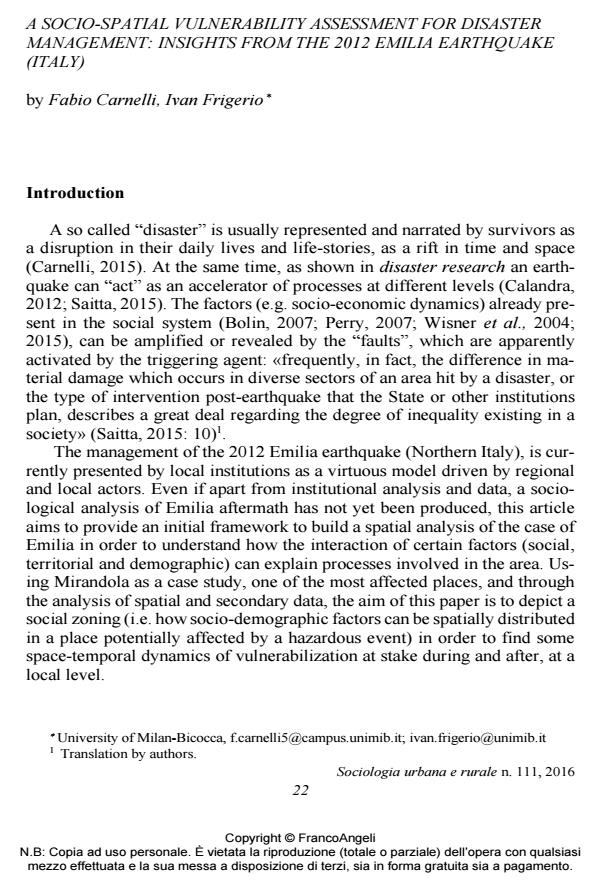A socio-spatial vulnerability assessment for disaster management: insights from the 2012 emilia earthquake (italy)
Titolo Rivista SOCIOLOGIA URBANA E RURALE
Autori/Curatori Fabio Carnelli, Ivan Frigerio
Anno di pubblicazione 2017 Fascicolo 2016/111
Lingua Inglese Numero pagine 23 P. 22-44 Dimensione file 1124 KB
DOI 10.3280/SUR2016-111002
Il DOI è il codice a barre della proprietà intellettuale: per saperne di più
clicca qui
Qui sotto puoi vedere in anteprima la prima pagina di questo articolo.
Se questo articolo ti interessa, lo puoi acquistare (e scaricare in formato pdf) seguendo le facili indicazioni per acquistare il download credit. Acquista Download Credits per scaricare questo Articolo in formato PDF

FrancoAngeli è membro della Publishers International Linking Association, Inc (PILA)associazione indipendente e non profit per facilitare (attraverso i servizi tecnologici implementati da CrossRef.org) l’accesso degli studiosi ai contenuti digitali nelle pubblicazioni professionali e scientifiche
This article aims to provide a framework to build a spatial assessment about the interaction between social vulnerability indicators and the 2012 Emilia earthquake. Using Mirandola as case study, five social vulnerability indicators were selected, mapped and spatially correlated to a building damage index calculated using geo-referenced information of damaged buildings available at a local level. The evaluation of this spatial relationship may be a useful tool for post-disaster recovery and reconstruction policies.
L’articolo si propone di costruire un quadro di valutazione territoriale circa l’interazione tra gli indicatori di vulnerabilità sociale e il terremoto dell’Emilia del 2012. Utilizzando Mirandola come caso di studio, cinque indicatori di vulnerabilità sociale sono stati selezionati, mappati e correlati spazialmente ad un indice di danno degli edifici, calcolato utilizzando informazioni georeferenziate degli edifici danneggiati disponibili a livello locale. La valutazione di queste relazioni socio-territoriali potrebbe costituire un utile strumento ai fini di policy di recovery e ricostruzione post-disastro.
Parole chiave:Vulnerabilità sociale, Terremoto dell’Emilia, analisi socio-territoriale, disaster management, disaster recovery, GIS, Mirandola.
- Geohazards and Disaster Risk Reduction Francesco De Pascale, pp.483 (ISBN:978-3-031-24540-4)
- Combining hazard, social vulnerability and resilience to provide a proposal for seismic risk assessment Oscar Luigi Azzimonti, Matteo Colleoni, Mattia De Amicis, Ivan Frigerio, in Journal of Risk Research /2020 pp.1225
DOI: 10.1080/13669877.2019.1646308 - An approach to measure resilience of communities to climate change: a case study in Calabria (Southern Italy) Loredana Antronico, Maria Teresa Carone, Roberto Coscarelli, in Mitigation and Adaptation Strategies for Global Change 20/2023
DOI: 10.1007/s11027-023-10056-7 - The impact of the L'Aquila earthquake on demographic changes Sara Miccoli, Cecilia Reynaud, Elena Ambrosetti, Francesca Licari, in Population, Space and Place e2689/2023
DOI: 10.1002/psp.2689 - Assessing community resilience, housing recovery and impact of mitigation strategies at the urban scale: a case study after the 2012 Northern Italy Earthquake Alberto Basaglia, Alessandra Aprile, Enrico Spacone, Luca Pelà, in Bulletin of Earthquake Engineering /2020 pp.6039
DOI: 10.1007/s10518-020-00919-8 - The Role of the Spatial Network in Urban Disaster Risk Variations: Reimagining the Notion of Spatial Vulnerability at the Urban Scale Monia Del Pinto, Ksenia Chmutina, Falli Palaiologou, Lee Bosher, in International Journal of Disaster Risk Science /2024 pp.303
DOI: 10.1007/s13753-024-00554-w - Mappare la vulnerabilità sociale e la resilienza di un territorio Oscar Luigi Azzimonti, Matteo Colleoni, Mattia De Amicis, Ivan Frigerio, in PRISMA Economia - Società - Lavoro 3/2018 pp.14
DOI: 10.3280/PRI2017-003002 - Identifying urban and rural settlement archetypes: clustering for enhanced risk-oriented exposure and vulnerability analysis Gabriella Tocchi, Massimiliano Pittore, Maria Polese, in Natural Hazards and Earth System Sciences /2025 pp.3665
DOI: 10.5194/nhess-25-3665-2025
Fabio Carnelli, Ivan Frigerio, A socio-spatial vulnerability assessment for disaster management: insights from the 2012 emilia earthquake (italy) in "SOCIOLOGIA URBANA E RURALE" 111/2016, pp 22-44, DOI: 10.3280/SUR2016-111002